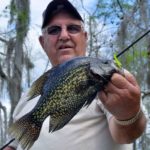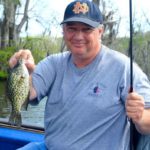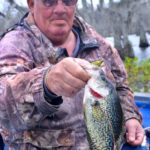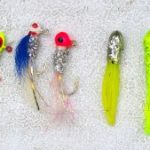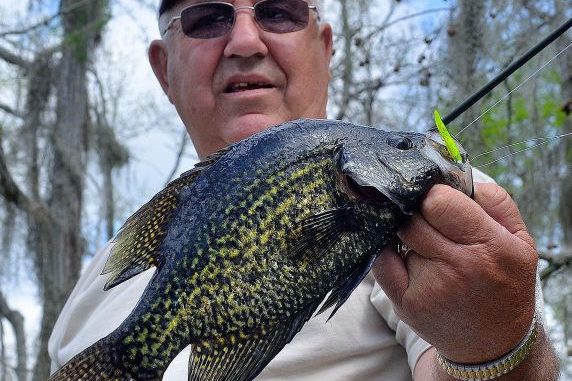
Chicot Lake sac-a-lait can be finicky, but when you find them you can catch some real slabs. Here are some tips on how to catch the state’s official freshwater fish.
In 1993, the Louisiana Legislature designated the “white perch” as the state’s official freshwater fish.
At first, many Louisianans — including more than just a few legislators — asked, “What exactly is a ‘white perch?’”
Being a Cajun with deep roots in Evangeline Parish, I figured someone in Ville Platte or Evangeline Parish had some political clout that year. And they must have played some good cards.
Looking back, times were sort of weird in our state. In 1991, Cajun Gov. Edwin Edwards began serving a fourth term after defeating former Ku Klux Klan grand wizard and state Representative David Duke.
Voters had approved a state lottery in 1990, and two years later the Legislature authorized riverboat and land-based casino gambling.
And we all know what happened years later — but let’s focus on positive thoughts about fishing the state’s beloved sac-a-lait.
Therefore, when the “white perch” became the freshwater State Fish of Louisiana, many questioned that deal as a possible lost bet in a smoke-filled, closed-room game of cards and whiskey bottle on the table.
What do these facts have anything to do whatsoever with anything at all?
Let’s just say that many are under the false notion that all Cajuns call crappie “sac-a-lait.”
If you venture into Ville Platte to buy shiners or jigs from Ike Launey of Industrial Supply and Sports on your way to Chicot Lake, you’ll hear the State Fish referred to as “white perch.”
And most of these great, sporting citizens in Ville Platte are, indeed, Cajuns.
So when you arrive at the gates of Chicot State Park, that’s a white perch on the entry sign, folks — although many Louisianans know them to be sac-a-lait, while nationally they’re called crappi.e”
Whatever you call them, Chicot Lake has plenty of these fish. But the vast majority of them are black “white perch,” so it gets confusing.
So we’ll just refer to them as “sac-a-lait” from here on out.
And Chicot Lake’s 1,642 acres, a flooded reservoir of what was once a vast bottomlands hardwoods swamp, are rich with prime habitat for slabs.
“Annual crappie numbers are cyclic at Chicot, just as in any other lake or reservoir, but there will be fish available every year to anglers,” said Jody David with the Louisiana Department of Wildlife and Fisheries. “These fish are so prolific that they can begin spawning when they’re only 5 to 6 inches in length.
“And about 90 percent of the crappie in Chicot Lake are black crappie, although anglers will catch a few white crappie on occasion.”
While locals know the lake can be finicky on any given day, Chicot can deliver grand numbers of crappie and bass.
The key to successful slab encounters, area sac-a-lait masters have learned, is to work hard.
One of the locals who has fished this lake and nearby Miller’s Lake all of his life is 69-year-old B.J. Fontenot, who will tell you there are hefty Chicot Lake sac-a-lait to be placed in the cooler on a good day.
He spends most days during the duck season in a blind at Miller’s Lake, but the rest of the year Fontenot keeps his boat ready to go on white perch trips.
And most of the time he spends fishing for sac-a-lait will be at Chicot or Miller’s lakes.
On April 1, my cousin Savoy’s Glynn Lavergne heard him talking loudly some yards away. Lavergne and I had about 20 sac-a-lait up to 1 ½ pounds in the cooler.
We had been catching these fish under alligator grass and hyacinths along the boat route to the Branch area on the west side of the lake channel.
“That’s B.J.,” Lavergne said.
So we motored over to visit and get a fishing update from Fontenot and his buddy Charles Hazard, also of Ville Platte.
“How y’all doing B.J.?” Lavergne asked.
“Well, Glynn, we got a few,” Fontenot said.
Fontenot took a few from his cooler for pictures, and said his success came on a Jenny’s Jigs hair jig in a new color (No. JJ033).
Jenney’s Jigs can be found at www.jennysjigs.com.
“Man, I caught them on that new hair jig today,” Fontenot said, as he placed one in his hand so I could take a quick photo. “But Glynn, I am still finding a few with small egg sacks in them. They are not in the trees yet; they’re still here under the grass.”
“We caught two males with black heads in the trees,” Lavergne said, referring to the deep, black coloration phase that develops in male sac-a-lait during the spawn. “For the most part, Chris and I found them under the grass too.”
A discussion ensued about whether or not somehow they had missed fishing during the spawn, or the possibility that it may have not happened as of yet.
After all, it was late — April 1, 2014 — and usually Chicot Lake’s crappie would have already run shallow near tupelo clusters on the north end of the lake to spawn.
But Chicot Lake waters had stayed very cold into the spring as the result of a much colder winter compared to previous years.
The fact is that by April 1 of any given year, the spawn is usually over at Chicot Lake.
LDWF’s David said it’s all a matter of water temperatures.
“When water temperatures range between 58 and 60 degrees, that’s prime for the sac-a-lait spawn,” he said. “The actual spawn will vary depending on location. It occurs sooner in shallow ponds, small lakes and small reservoirs especially in the south.
“In larger reservoirs such as Toledo Bend, it may occur at different times in many locations due to water temperature variations in such a large system.”
In other words, there is no exact time or date when the prespawn or spawn will occur.
Another misunderstanding is that female and male crappie will all go to the shallow flats at the same time.
“It is not a one-day affair,” David said of the move to spawning areas. “Usually it will take no more than a month in any given location, but in larger reservoirs (e.g., Toledo Bend) it may extend for a longer period.”
According to David, Chicot Lake sac-a-lait can average up to a pound.
Fontenot and Lavergne regularly catch fish ranging from ¾ to 1 ½ pounds, with a few occasions reaching 2-pound.
Even if water temperatures have moved above 60 degrees this month, there are locations in Chicot Lake to check to see if there are any spawning sac-a-lait remaining.
For example, clusters of tupelo trees near the shorelines leading to the Branch area could hold some leftover spawners.
“If the spawn should (extend into) early April, I’ll find them in the tupelo clusters near the banks,” Lavergne said. “They will also be along the shorelines in 2 to 4 feet of water.
He and Fontenot pointed out that tupelo clusters are plentiful in many coves in the lake.
Fontenot recalled a special trip to that area shared with fishing friend Mark Manual that proved spawning sac-a-lait can be found in the area.
“Mark and I went to the trees in the Branch area, and they were there,” Fontenot said. “On that day, we caught 17 good ones. We went back Friday that week, we had another seven slabs but the sky opened up on us.”
But it can change quickly.
“When I went the following week, the fish were gone,” Fontenot said.
The only problem with fishing the spawning period is that anglers run the risk of never catching a fish if all they do is troll the banks and cast a tube or shiner under a cork or without one.
So flexibility is important. If there are no bites on the shallow trees and shorelines, it’s important to back out to grass mats early, since these fish will stop biting at some part of the day.
“When the spawn is over, we catch them in the channel by the spillway all the way to the north landing,” Fontenot said.
They let the fish tell them if they need to fish under a cork, or whether tight-lining is the best way to go.
“Fishing without a cork, we cast a hair jig, grub or tube jig and you just reel it in. We call that the ‘Acey’ way,” Fontenot said, referring to a friend who taught him this method.
